
3275
.pdfIssue № 4 (48), 2020 |
ISSN 2542-0526 |
While performing a set of measures, these conditions can contribute to improving the ecological state and the appearance of cities and towns, create a more comfortable microclimate, sanitation and hygiene as well as aesthetics in the streets, residential apartments, public places (parks, boulevards, squares, squares, etc.).
An extensive number of studies is indicative of an interest in this topic. The article by O. A. Petrina and M. E. Stadolin explores the major problems and tendencies of organizing a comfortable urban environment are discussed [20]. It is noted that technological backwardness and a high level of wear and tear of communal infrastructure facilities call for direct participation of the state in the reconstruction and modernization of communal facilities within the framework of state project financing [9]. In the article [4], the authors points out the need to employ innovative approaches to the development of urban space concluding that the conservation and degradation of the recreational zone is unacceptable, the need is reinforced to ensure the satisfaction of the growing demands of citizens regarding the quality and availability of recreational services. In St. Petersburg, there is a positive experience of designing such creative spaces. The historical and business center of this city is saturated with areas of what were once successful industrial enterprises that are in almost no demand these days, but back in 2014 in the “Strategy for the Economic and Social Development of St. Petersburg for the Period up to 2030” the need to develop new creative spaces, including by means of the transformation of unused industrial facilities was identified as one of the priority areas of social and economic development [10].
Territories for improvement were selected based on the findings of urban planning studies, interviews with local residents and experts in the field of architecture and urban planning, as well as approval of the administration. Popular points of the city were identified based on research of activity on social networks. In each city participating in the program, key spaces and territories were selected that would be attractive to citizens and tourists, but require highquality renovation and modernization [2, 11].
A comfortable, safe and creative urban space is appealing not only for city residents, but also for tourists and investors who have a positive impact on the city’s economic component [12, 13]. The possibilities of urban recreation facilities should be assessed by the characteristics of the landscape and recreational quality of facilities in general, indicators of landscape and ecological assessment, including the ecological recreational capacity, and the value of the territorial potential in the size of functional zones.
In Krasnodar, at the Urban Environment forum on July 24, 2017, which was organized by the All-Russian Party United Russia, Alexandra Sytnikova, partner of Strelka Business Consul-
51

Russian Journal of Building Construction and Architecture
ting, spoke about the improvement program for Russia’s 40 largest cities. Design projects of key public spaces in these 40 cities are being developed in collaboration with the foundation of a single development institute in the housing sector, architectural companies and young architects supported by the Ministry of Construction of the Russian Federation. Over the next five years, from Kaliningrad to Vladivostok, more than 230 public spaces with a total area of over 1200 hectares will be landscaped. Among them are 20 parks, 127 streets, 45 squares, 43 embankments. As part of this improvement program, a competitive project was developed for the improvement of the alley in the street. Ordzhonikidze, called “Alley of Architects” in the city.
The major task in implementing the draft design is to create a modern functional space that meets all norms, trends and needs.
As part of this program, a project has already been implemented to design a modern public space in Sovetskaya Square, which caters for the needs of all groups of the population and has all the qualities to be the leading platform for public events in the city as well as the major venue for meetings and recreation. Similar projects were implemented in Novosibirsk, Orenburg, Belgorod and a lot of other cities of Russia.
The objective of the project is to design a public space that meets all the criteria for the comfort and safety of the city. It is essential to address the following tasks:
––to involve residents in the implementation of the project at all stages;
––to design open and free space for different groups of the population;
––introduce technologies of urban informatics to improve the efficiency of services and cater for the needs of residents;
––to form the architectural and landscape uniqueness of the territory.
Hence this environment can be a sub-center of the main core of the city centre, solved in harmonious contrast of the regular planning system - solemn, restrained and architecture of postwar classicism –– with a picturesque, dynamically evolving environment of the cultural and entertainment space [6].
1. Analysis of the territory. The design area is located in the historic center surrounded by lots of churches, squares, theaters and museums. It also links all of these objects. Since Voronezh is considered a city of students due to having a large number of educational institutions, the improvement of this territory will create new points of interest and leisure activities for the youth. An analysis of the existing territory was performed based on which it became possible to formulate the following problems:
––the existing heating pipeline crosses the territory along;
––insufficiently functional filling of the territory;
52
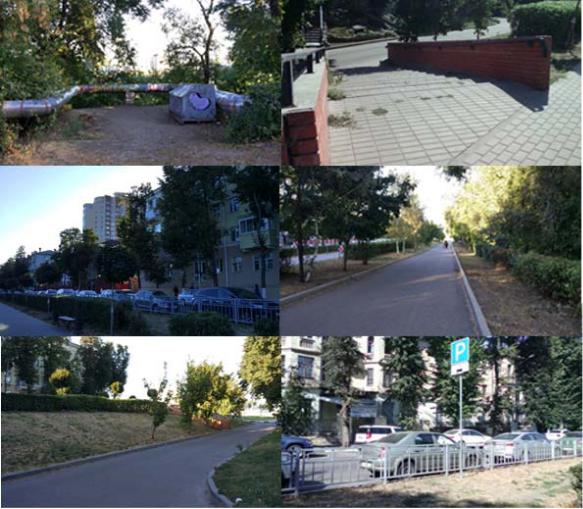
Issue № 4 (48), 2020 |
ISSN 2542-0526 |
––the territory is insufficiently lit;
––chaotic parking of light vehicles;
––vintage points are blocked, greenery is not well-manicured;
––the surfacing of the pedestrian zone is outdated.
Fig. 1 presents the above existing problems of the territory of the site.
Fig. 1. Problems of the existing section of the territory (photo by the author)
The location of the site on the shores of the Voronezh reservoir opens up large horizons for the design of key elements of landscaping, panoramic and viewpoints surrounded by green areas [7]. The analysis of the technical and economic indicators of the created territory showed a decrease in the area of the roadway with the expectation of the subsequently designing a fountain zone. A slight decrease in the territory of landscaping with the need to eliminate the unorganized planting of vegetation is designed for it to comply with the design and environmen-
53
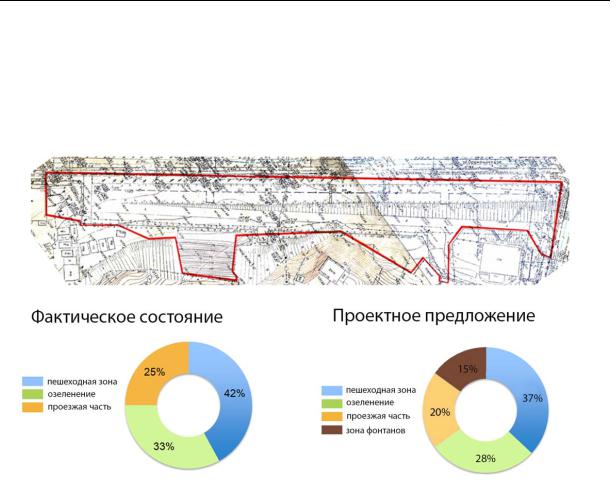
Russian Journal of Building Construction and Architecture
tal requirements. The topographic survey data and the boundaries of the design site were provided by the organizers of the competition. Fig. 2 shows the technical and economic indicators of the site.
Boundaries of the designing area, square 9935 m2
|
Actual condition |
Design solution |
||
|
|
|
|
|
|
|
|
|
|
|
Pedestrian zone |
|
|
|
|
|
Pedestrian zone |
|
|
|
Green zones |
|
|
|
|
|
Green zones |
|
|
|
Traffic |
|
|
|
|
|
Traffic |
|
|
|
|
|
|
|
|
|
|
||
|
|
|
Fountain zone |
|
|
|
|
|
|
Fig. 2. Technical and economic indicators of the area
Natural bionic forms, which are characterized by environmental friendliness and do not introduce any inconsistencies either into the existing historical urban development or into natural landscapes, were accepted as the foundation for designing the concept of landscaping the territory.
The pace and development of the compositional planning, structural and functional framework of the city should be defined by the need to preserve its integrity as a complex multilevel system, i.e. direction and pace, forms and principles of its overall structure.
2. Principles of the project. While developing the design project, five complementary principles were considered. If they are complied with, the main goal of the project, which is to improve the quality of the urban environment, will be achieved.
The first principle is comfort. Comfort means the convenience of using one or another open urban space and implies, first of all, its 10-minute pedestrian accessibility (within a radius of no more than 800 m), the absence of noise, visual and microclimatic pollution as well as easy operation.
The second principle is sustainability. In compliance with the principle of sustainability, all open spaces must represent a healthy environment that meets the requirements of sustainable
54
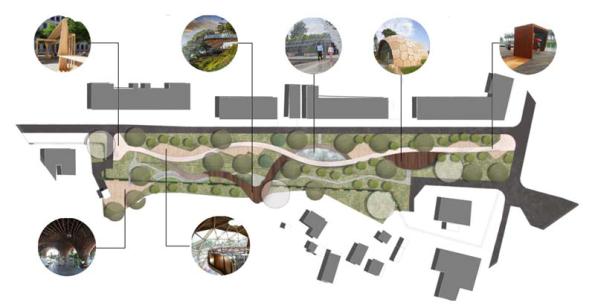
Issue № 4 (48), 2020 |
ISSN 2542-0526 |
development. This includes ensuring adequate air quality, landscaping, water resources, and energy efficiency in use and maintenance.
The third principle is diversity. Any open urban space should be functionally diverse, including the leisure interests of at least three groups of users with no consideration of recreational opportunities designed for all citizens (cafes, pavilions, kiosks, etc.) [18, 20].
The fourth principle is safety. Minimizing the risk of injury while using public space is achieved by ensuring the visibility of the territory, organizing additional lighting, etc.
The fifth principle is identity. In environmental improvement projects, it is important to preserve and emphasize the city’s unique character bursting with history and traditions. Competent integration of modern solutions with the environment should bring the historic look back. At the moment, a large number of public spaces in Voronezh city centre, valuable from the point of view of the history and culture of the city, have lost their significance and are in a dilapidated condition. Most of the large public spaces are used only during festive events. Outside the holidays they are not popular due to the lack of various functional improvement zones. However, these buildings could potentially be used to lure in tourists.
3. Design solutions. The area is an elongated shape. It is located between a slope with an active relief and residential buildings of low and medium storeys, along a one-way highway. Considering the location of the projected territory in the quiet city center surrounded by a large number of business centers, offices and commercial facilities, a decision was made to come up with concept of a modern transit-business public space with the introduction of elements of a “smart” city.
|
|
Fountain zone |
|
Exhibition zone |
|
|
|
|
|
|
Entrance group 2 |
||
Observation deck |
|
|||||
|
|
|
|
|
||
|
|
|
|
|
|
|
Summer café |
|
Coworking zone |
|
|
|
Fig. 3. General plan of the alley (design solution by the author)
55

Russian Journal of Building Construction and Architecture
The concept of a smart city ("SMART-city") involves the modernization of the city's infrastructure with fundamentally new capabilities of centralized management, a new level of services and security provided [5, 8]. This strategic development integrates the various factors of urban development into a single system. Figure 3 shows the functional areas.
In the planning structure, the main alley along the existing roadway is highlighted. Several minor footpaths lead to a cantilever observation deck thus increasing the recreation area and hiding the existing surface heating pipeline under the deck. There are two main entrances to the alley from the opposite sides, along the alley. The entire territory is divided into various functional areas as shown in Fig. 3:
––exhibition zone with a pavilion and a place for outdoor exposition;
––the zone of “dry” fountains which is a logical continuation of the route from Sovetskaya Square in Voronezh;
––an observation deck with a panoramic view of the city;
––coworking area with modern mobile pavilions;
––a summer cafe area with access from the main street for maintenance.
At the moment in Ordzhonikidze Street there are crossings each 100 m. With this design solution, it is suggested that the street is equipped at one level with a speed limit of up to 20 km/h. Then pedestrian crossings are essential. In the street the pedestrian crossing is raised (one level with the sidewalk). This will force the cars to slow down further in order to go 7––15 cm up.
Urban social space it is currently still not accessible for people with limited mobility [14, 17]. However, the modern universality of the architectural environment presupposes the equal participation of individuals with disabilities in all spheres.
For the sake of the convenience of pedestrians (especially low-mobility groups of citizens), the entrances to the intra-quarter territories are arranged in the same level as the pedestrian zone. In some places they are equipped with curb ramps. Pedestrian crossings are raised. The organization uses tactile surfacings that attract the attention of pedestrians and encourage them to concentrate. Entrances for people with limited mobility are made with ramps [1].
The distance between trees when planting is no less than the width of the crown of a mature tree. It is necessary to provide for root barriers to prevent root overgrowth. The trees were planted at a distance of more than 5m away from buildings. The level of the soil was raised 0.55 m above the level of the adjacent cover in order to prevent the release of various reagents and chemicals into the soil.
Parking spaces in the parking lot along the street alternate with greenery in every five spaces. This arrangement of the parking lot is the best tool for ensuring the safety of pedestrian traf-
56
Issue № 4 (48), 2020 |
ISSN 2542-0526 |
fic: parked cars protect pedestrians from passing vehicles. Nowadays there are various ways to address car storage problems. The easiest way to improve the parking situation is to apply markings appropriate to the size of the car in places where parking is possible [3, 15]. When designing the parking, the street was analyzed and the locations of the taxi parking, loading and unloading pockets were indicated.
As the traffic volume is average, the most viable option is to organize the combined movement of cyclists and pedestrians. The separation of bicycle and pedestrian flows is made visually through the use of road signs, markings, changing materials and color of the coating.
There are a lot of lighting options - both functional and decorative ones. For the convenience of movement and orientation of users, parking lots for visitors, entrances, main cycle and pedestrian paths, as well as secondary paths leading from residential buildings to areas of everyday recreation are lit. After 11p.m. the illumination brightness is halved in order to reduce light pollution of natural areas. To increase the level of user safety, not only is the path itself illuminated, but also are the adjacent landscaping areas, elements of recreational, social and other infrastructure. To increase the attractiveness, decorative lighting of trees, fountains and elements of urban furniture were also employed.
Using a hedge as a noise screen from the roadway will allow one to address two problems simultaneously: ecological and aesthetic ones [16, 19]. The “green wall” will not only serve as a fence, but will also assisit in the functional zoning of the territory.
Information signs are placed along the main and secondary paths, at intersections and route changes. Additionally, there are navigation elements before the start of the cycling trails. The main walking routes, recreational areas and event areas are equipped with a radio notification system. There are also emergency call buttons in the night lights.
In the green areas, local relief descends have been arranged in order to collect wastewater. Water-permeable coverings were employed in bicycle and pedestrian paths and grounds. Also, bio-drainage ditches, rain gardens, trenches were employed to regulate rainwater.
The park provides all the necessary measures for access of people with limited mobility, there are ramps, smooth ascents to the observation deck. Each object or installation is provided with a description in Braille, there are tactile tiles along all directions of movement.
The observation deck offers a view of the Voronezh reservoir, and the active relief makes it multi-stage, which can considerably increase the capacity of visitors. Basically, all cities are formed near water reservoirs, and their shores are one of the most popular recreation areas for the population, particularly in conjunction with green areas and public spaces. In this
57
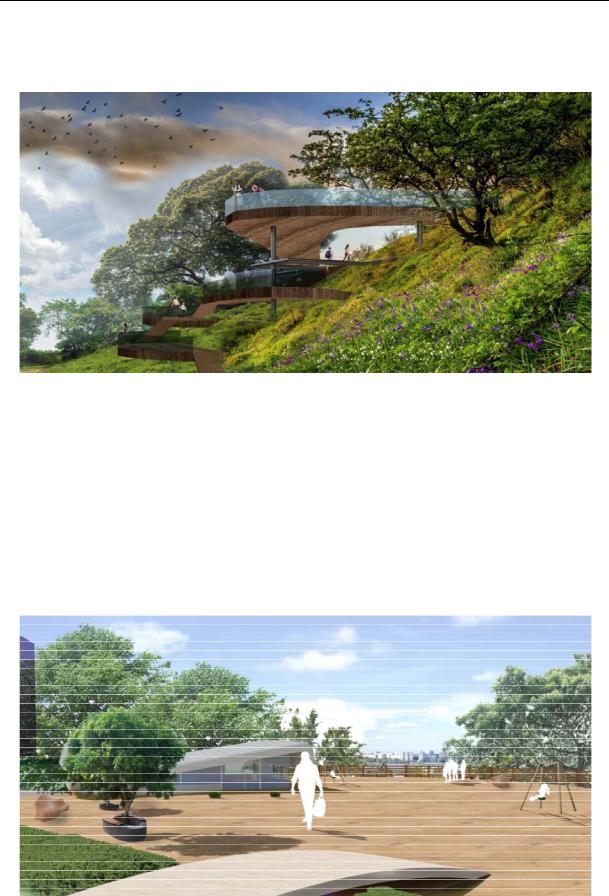
Russian Journal of Building Construction and Architecture
area, it is possible to conduct open-air lectures and seminars. The observation deck area is shown in Fig. 4.
Fig. 4. Observation deck (design solution by the author)
Large open spaces facilitate the organization of thematic exhibitions. The transit zone allows the exhibits to be arranged evenly.
In modern society, it is impossible to ignore spaces and areas for temporary joint use as a work office, in other words, coworking areas. They allow both students and young professionals to work in a modern environment enjoying a beautiful view. The cafe and coworking area is shown in Fig. 5.
Fig. 5. Café and coworking area (design solution by the author)
58
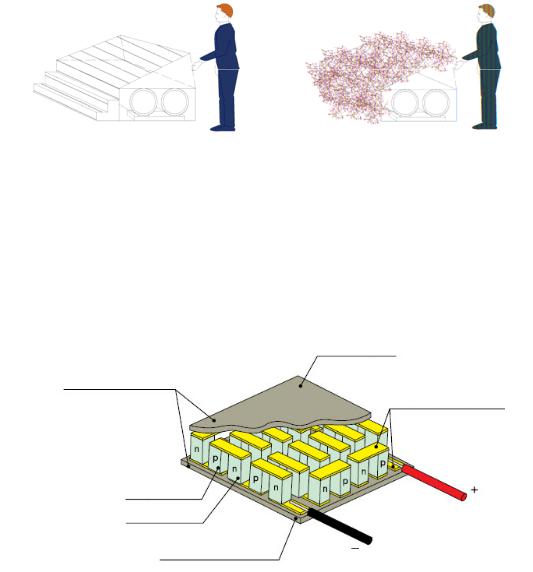
Issue № 4 (48), 2020 |
ISSN 2542-0526 |
The major problem of this site is the open heating network which runs along the entire site and undermines the physical appearance of the alley. There are two possible solutions: to bury the heating system in the ground or to integrate it into the landscape design with constant access for its maintenance. The stepped box covering the heating network can be used as a bench, alternating the box shelter with the greenery-decorated parts. The options for access to the heating network are presented in Fig. 6.
Fig. 6. Options for accessing the heating network (design solution by the author)
The problem with an open heating network can be turned into an energy source. Since there is a certain temperature on the surface of the pipeline throughout the year, its correct use and transformation will enable the use of energy for charging street stations, autonomous decorative lighting, etc.
Hot side
Ceramic plates
Metal contacts
p-type TEE
n-type TEE
Cold side
Fig. 7. Thermal electrical generative modulus in a cut
Thermoelectric modules (TEM) in modern practical devices are structurally complete devices in which a single element is a thermocouple comprised of two dissimilar semiconductor elements with p- and n-types of conductivity. The elements are connected in series with each
59
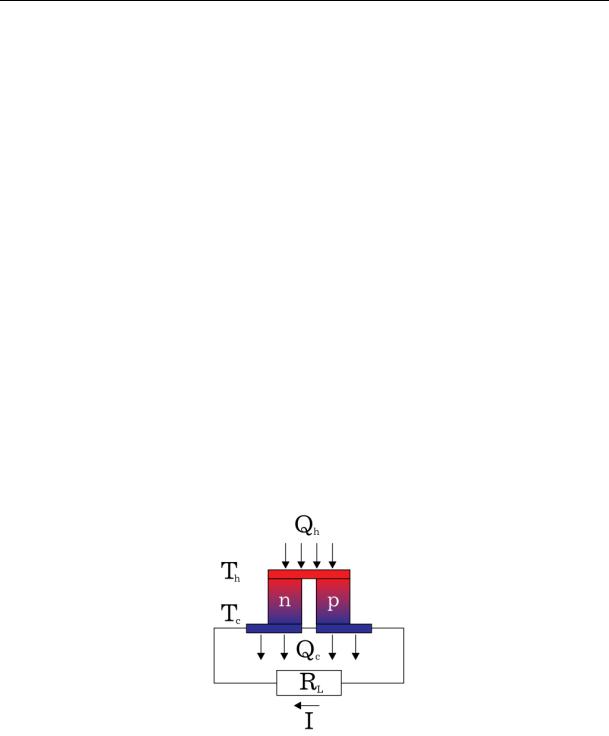
Russian Journal of Building Construction and Architecture
other using connecting plates and placed between two flat ceramic plates based on aluminum oxide or nitride. In this case, from the point of view of heat fluxes, all thermoelectric elements are connected in parallel. The principle of the TEM device is shown in Fig. 7 (borrowed from publicly available Internet resources that do not contain references to the authors of these materials and any use restrictions). The principle of THM is based on the Seebeck effect.
The Seebeck effect is a thermoelectric effect consisting in the appearance of a thermo-EMF when a contact (junction) is heated up between two dissimilar metals or semiconductors. The thermo-EMF voltage is directly proportional to the Seebeck coefficient E and the temperature difference ΔT between hot Th and cold Tc sides (junctions) of the thermoelectric module:
(1) In order to create a temperature difference on the sides of the TEM, it is essential to supply the heat flux Qh to its hot side and to remove the heat flow Qc from the cold side, and their difference according to the law of conservation of energy will be the electric power P. The principle of operation of the TEM is shown in Fig. 8 (borrowed from public Internet resources that do not contain references to the authors of these materials and any use restrictions:
P Qh Qc . |
(2) |
Fig. 8. Principle of the operation of the TEM
The Seebeck effect is employed, e.g., while measuring temperatures with thermocouples; the Seebeck effect is based on the action of thermoelectric generators.
The use of thermoelectric generator modules (TGM) at different times of the year can provide energy. During the heating period when they are located on the surface of the pipeline under conditions of a temperature difference between the heat conductor and the environment, the
60
